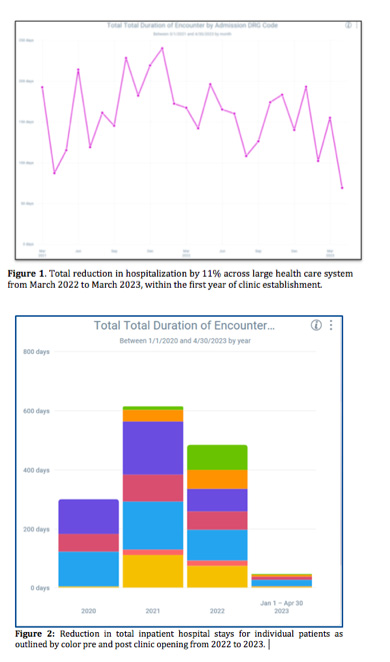Introduction:
The lack of comprehensive care for adult patients with sickle cell disease (SCD) remains a major unmet need in the United States, leading to the noted increase acute care utilization, high morbidity and mortality as well as increased healthcare burden. By establishing a dedicated adult center, the delivery of SCD care will be moved from the acute to the outpatient setting where best practices of disease management and a trusting therapeutic relationship can be established. This will allow for timely detection of complications and address the psychosocial contributors to disease management. Here, we demonstrate how the establishment of a dedicated adult sickle cell results in direct and immediate improvement in acute care utilization and patient outcomes.
With funding from our institution and health department, Inova Adult Sickle Cell Center (IASC) was established in March of 2022. After IASC opening, each provider's schedule allowed for frequent clinic visits to apply standard of care and address timely unmet needs, particularly those with highest disease burden and acute care use.
Methods/ Results:
With IASC opening, disease-modifying therapies, screening studies and individualized care plans (ICPs) were implemented for each patient. Equally important and perhaps a key factor for IASC funding was the degree of acute care utilization within our hospital system which comprises of five large hospitals including a 1000-bed tertiary care center as well as numerous standalone ED facilities. To standardize care across this large institution, we quickly developed ICPs for all IASC patients and provided education to ED and hospitalist colleagues. In line with other adult sickle cell centers, we eliminated use of parenteral diphenhydramine as well intermittent parenteral opioid bolus use. Instead, patient controlled anesthesia (PCA) pumps were utilized along with oral opioids. Upon admission, the care for each patient was closely coordinated between IASC and inpatient teams. We also identified several patients with frequent hospitalizations for comprehensive care plan meeting. The patients consisted of all sickle genotypes, males and females and predominately in the second and third decade of life. The care plan meeting consisted of IASC team, the patient and his or her identified caregiver(s). In this meeting, barriers to care including psychosocial support, food and housing insecurity and transportation needs were identified. Patient's sickle cell disease and comorbidities were reviewed and goals of care agreed upon. Patients were then seen weekly to continue ongoing discussions and management of underlying disease, psychosocial support and monitoring of acute care and opioid use.
Within IASC's first year, interim analysis showed of the 1439 total hospital days saved from all service lines, 864 were predominately SCD. The total number of admission days across the system was continuously rising until opening of the IASC in March 2022 and within a year, we saw a reduction in total hospital days by 11% which equates to tremendous cost savings (Fig. 1). Moreover, for each of our identified highest acute care utilizing patients, we noted a dramatic reduction in hospitalization after clinic opening with aggressive disease management and frequent clinic visits (Fig. 2).
With IASC opening, we were able to begin implementation of disease modifying therapies including enhanced hydroxyurea compliance as well as initiation of vaccinations and screening studies including nephropathy and iron overload. These changes were nearly a 100% increase from the year before given that patients were not receiving comprehensive care.
Conclusion:
Individuals with SCD without a ‘medical home’ face many barriers to care including access to regular clinic visits where ongoing education and gaps in care can be identified including physical, psychological, and social impact. It is important for sickle cell providers to account for all aspects of a patient's well-being when devising individual treatment strategies. Caring for a sickle cell patient is complex and time consuming and best done by sickle cell disease experts in a dedicated center. Using data from our center in our large healthcare system, we demonstrate that a dedicated adult sickle cell center allows for much improved overall patient outcomes and decreased healthcare burden by moving the delivery of care form the inpatient to outpatient setting.
Disclosures
Ershler:Pfizer: Other: Advisory board, Research Funding, Speakers Bureau; Pharmacosmos: Other: Advisory board, Speakers Bureau; Novartis: Other: Advisory board; Responder's office, Speakers Bureau; Global Blood Therapeutics: Other: Advisory board; Responder's office.


This feature is available to Subscribers Only
Sign In or Create an Account Close Modal